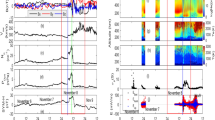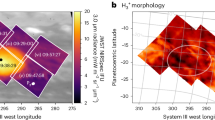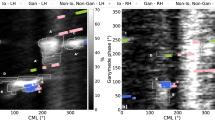Abstract
Io, Jupiter's innermost Galilean satellite, plays a major part in determining when jovian decametre storms are observed1. Specifically, as a result of beaming of the radiation at a preferred angle to the local magnetic field, the most favourable satellite locations for the reception of emission are approximately 90° and 240° γIo (departure of Io from superior geocentric conjunction). Recently a second-order effect has been noted—a periodic displacement in the particular γIo phase at which the reception probabilities are observed to peak2–4. The modulation has a peak-to-peak magnitude of 5° to 10°, a period of about 12 yr, and is most pronounced in the case of the jovian decametre storm sources Io–B and Io–C. (There is not yet general agreement as to the behaviour of Io–A.) The effect has been tentatively correlated with the ±3.5° variation in the jovicentric declination of the Earth, DE; however, it has also been considered3 that it may be a consequence of changes intrinsic to the jovian activity cycle. Here we interpret this phenomenon simply in terms of the latitudinal variations inherent in the Earth–Jupiter viewing geometry as defined by the 12-yr cycle in DE. Furthermore, we show that the phase of the Io–B and Io–C displacements relative to DE phase uniquely defines the hemisphere, north or south, from which the radiation associated with each source is beamed. The results agree with, and lend credence to, the source positions as inferred from polarimetry5,6 and more recently from considerations of planetary-limb shadowing7.
This is a preview of subscription content, access via your institution
Access options
Subscribe to this journal
Receive 51 print issues and online access
$199.00 per year
only $3.90 per issue
Buy this article
- Purchase on SpringerLink
- Instant access to full article PDF
Prices may be subject to local taxes which are calculated during checkout
Similar content being viewed by others
References
Bigg, E. K. Nature 203, 1008–1010 (1964).
Lecacheux, A. Astr. Astrophys. 37, 301–304 (1974).
Thieman, J. R., Smith, A. G. & May, J. Astrophys. Lett. 16, 83–86 (1975).
Bozyan, F. A. & Douglas, J. N. J. geophys. Res. 81, 3387–3392 (1976).
Kennedy, D. J. thesis, Univ. Florida (1969).
Carr, T. D. & Desch, M. D. in Jupiter (ed. Gehreis, T.) 693–737 (University of Arizona Press, 1976).
Alexander, J. K., Smith, R. A., Kaiser, M. L., Acuna, M. H. & Thompson, R. F. Goddard Space Flight Centre Rep. X-693-75-258 (1975).
Smith, E. J., Davis, L., Jr & Jones, D. E. in Jupiter (ed. Gehreis, T.) 788–829 (University of Arizona Press, 1976).
Author information
Authors and Affiliations
Rights and permissions
About this article
Cite this article
DESCH, M. Io-phase motion and jovian decametre source locations. Nature 272, 339–340 (1978). https://doi.org/10.1038/272339a0
Received:
Accepted:
Published:
Issue date:
DOI: https://doi.org/10.1038/272339a0
This article is cited by
-
Drift rates of Jupiter's S-bursts
Nature (1979)



